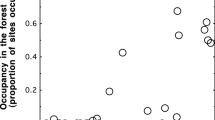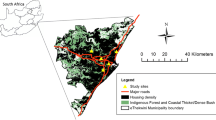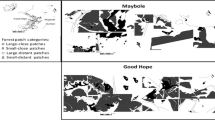Abstract
The aim of this study was to assess the impact of isolation on forest bird communities in agricultural landscapes in The Netherlands. We studied the avifauna of 235 small (0.1–39 ha) woodlots composed of mature deciduous trees in 1984–1985. These woodlots were selected in the eastern and central/southern part of the country within 22 regions showing great differences in landscape structure,i.e., degree of isolation. Multiple regression analysis indicated that woodlot size was the best single predictor of species number and probability of occurrence of most species. It turned out that the isolation variables, area of wood, number of woods, interpatch distance, and proximity and density of connecting elements, explained small but significant parts of the residual variances in species number. No single species was significantly affected by the density of connecting elements. Biogeographical differences between two groups of regions were emphasized. Evidence of four woodland species suggested that regional abundance affected the probability of occurrence in small isolates.
Similar content being viewed by others
References
Alvey, N., Galwey, N. and Lane, P. 1982. An introduction to Genstat. Academic Press, London.
Ambuel, B. and Temple, S.A. 1983. Area-dependent changes in the bird communities and vegetation of southern Wisconsin forests. Ecology 64(5): 1057–1068.
Askins, R.A., Philbrick, M.J. and Sugeno, D.S. 1987. Relationship between the regional abundance of forest and the composition of forest bird communities. Biol. Conserv. 39: 129–152.
Bull, A.L., Mead, C.J. and Williamson, K. 1976. Bird-life on a Norfolk Farm in relation to agricultural changes. Bird study 23: 163–182.
Brown, J.H. and Kodric-Brown, A. 1977. Turnover rates in insular biogeography: effect of immigration on extinction. Ecology 68: 445–449.
Burgess, R.L. and Sharpe, D.M. 1981. Forest island dynamics in man-dominated landscapes. Springer Verlag, New York.
Connor, E.F. and McCoy, E.D. 1979. The statistics and biology of the species-area relationship. Am. Nat. 113: 791–833.
Forman, R.T.T., Galli, A.E. and Leck, C.F. 1976. Forest size and avian diversity in New Jersey woodlots with some landuse implications. Oecologia 26: 1–8.
Freemark, K.E. and Merriam, H.G. 1986. Importance of area and habitat heterogeneity to bird assemblages in temperate forest fragments. Biol. Conserv. 36: 115–141.
Galli, A.E., Leck, C.F. and Forman, R.T.T. 1976. Avian distribution patterns in forest islands of different sizes in central New Jersey. Auk 93: 356–364.
Hanski, I. 1982. Dynamics of regional distribution: the core and satellite species hypothesis. Oikos 38: 210–221.
Hanski, I. 1985. Single-species spatial dynamics may contribute to long-term rarity and commonness. Ecology 66(2): 335–343.
Helliwell, D. R. 1976. The effect of size and isolation on the conservation value of wooded sites in Britain. J. Biogeogr. 3: 407–416.
Howe, R.W. 1984. Local dynamics of bird assemblages in Australia and North America. Ecology 65(5): 1585–1601.
Hustings, M.F.H., Kwak, R.G.M., Opdam, P.F.M. and Reijnen, M.J.S.M. 1985. Natuurbeheer in Nederland. Vol. 3 Vogelinventarisatie. Pudoc, Wageningen.
Jones, H.L. and Diamond, J.H. 1976. Short-time-base studies on turnover in breeding bird populations on the California Channel islands. Condor 78: 526–549.
Kwak, R. and R. Meijer. 1985. Species-specific acceptance levels in the mapping method.In Bird Census and Atlas Studies. pp. 73–82. Edited by K. Taylor, R.J. Fuller and P.C. Lack. British Trust for Ornithology, Tring.
Lunch, J.F. and Whigham, D.F. 1984. Effects of forest fragmentation on breeding bird communities in Maryland, USA. Biol. Conserv. 28: 287–324.
MacClintock, L., Whitcomb, R.F. and Whitcomb, B.L. 1977. II. Evidence for the value of corridors and minimization of isolation in preservation of biotic diversity. Am. Birds 31(1): 6–12.
Martin, T.E. 1981. Limitation in small habitat islands: chance or competition? Auk 98: 715–734.
Merriam, H.G. 1984. Connectivity: a fundamental ecological characteristic of landscape pattern.In Methodology in Landscape Ecological Research and Planning. Vol. 1, pp. 5–15. Edited by J. Brandt and P.A. Agger. Roskilde.
Moore, N.W. and Hooper, M.D. 1975. On the number of bird species in British woods. Biol. Conserv. 8: 239–250.
Noorden, B. van 1986. Dynamiek en dichtheid van bosvogels in geïsoleerde loofbosfragmenten. Report 86/19. Research Institute for Nature Management, Leersum.
Opdam, P. and Schotman, A. 1986. De betekenis van structuur en beheer van bossen voor de vogelrijkdom Ned. Bosbouwtijdschr. 58: 21–33.
Opdam, P., Van Dorp, D. and Ter Braak, C.J.F. 1984. The effect of isolation on the number of woodland birds of small woods in the Netherlands. J. Biogeogr. 11: 473–478.
Opdam, P., Rijsdijk, G. and Hustings, F. 1985. Bird communities in small woods in an agricultural landscape: effects of area and isolation. Biol. Conserv. 34: 333–352.
Ter Braak, C.J.F. and Looman, C.W.N. 1986. Weighted averaging, logistic regression and the Gaussian response model. Vegetatio 63: 3–11.
Whitcomb, R.F., Robbins, C.S., Lynch, J.F., Whitcomb, B.L., Klimkiewicz, M.K. and Bystrak, D. 1981. Effects of forest fragmentation on avifauna of the eastern deciduous forest.In Forest Island Dynamics in Man-dominated Landscapes. pp. 125–205. Edited by R.L. Burgess and D.M. Sharpe. Springer, New York.
Wiens, J.A. and Rotenberry, J.T. 1981. Censusing and evaluation of avian habitat occupancy. Studies in avian biology 6: 522–532.
Wright, S.J. 1985. How isolation affects rates of turnover of species on islands. Oikos 44: 331–340.
Wright, S.J. and S.P. Hubbell 1983. Stochastic extinction and reserve size: a focal species approach. Oikos 41: 466–476.
Author information
Authors and Affiliations
Rights and permissions
About this article
Cite this article
van Dorp, D., Opdam, P.F.M. Effects of patch size, isolation and regional abundance on forest bird communities. Landscape Ecol 1, 59–73 (1987). https://doi.org/10.1007/BF02275266
Issue Date:
DOI: https://doi.org/10.1007/BF02275266




